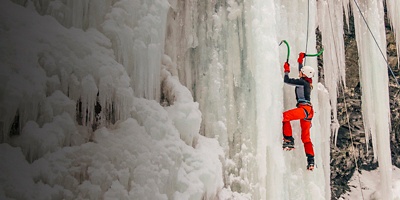
When you tell family and friends that you’re going ice climbing, you’ll probably hear one common refrain: “Ice climbing? Sounds cold.” Well, yes and no. It’s winter, and you’ll experience serious cold while belaying a partner, but you’ll be working hard while climbing, generating serious body heat. Fortunately, you can keep cozy through an entire day of ice climbing provided you’re wearing the right layers and are proactive about managing them.
Here’s what to wear ice climbing to stay warm, dry, and comfortable. Below, you’ll also find a few tips on how to get the most benefit from your layering system.
Upper Body
Baselayers: Warmth starts at the skin level. For warmer days or steeper hikes, a thin wool or synthetic T-shirt might be just fine. For colder days, your baselayer should be a synthetic or wool long-sleeve.
Midlayers: Ice climbing midlayers are pretty similar to rock climbing midlayers: Any synthetic fleece, insulated vest, or technical outdoor sweater will help you stay warm without overheating as you climb. Look for sweaters or jackets with full zippers to help you vent heat.
Insulated Layers: Many climbers bring both a midweight insulated jacket as well as a big down belay parka or “crisis puffy” in case temps really start to drop. For this, just look for the biggest jacket you can find and/or afford—nothing is too warm for an ice climbing belay.
Softshell: Many ice climbers prefer more breathable softshell jackets over hardshells for climbing in cold, dry conditions. There are both insulated and uninsulated softshells. An insulated softshell can double as your midlayer, but uninsulated softshells give you more layering options and finer control over your internal thermostat. A thin, uninsulated softshell can also help you keep snow off your skin when you’re working hard in mild conditions.
Hardshell: For temperatures right around or above freezing, you’ll need a hardshell jacket. Most ice climbs in the U.S. are frozen waterfalls—and they can become unfrozen pretty quickly if the sun peeks out. Always bring a hardshell in case of drips, sleet, or snow.





















